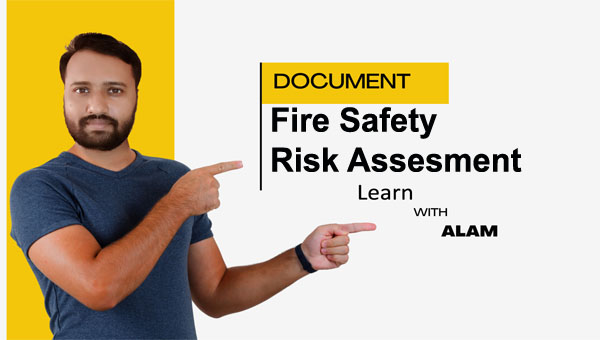
Fire Safety Risk Assessment: Step-by-Step Guide
Original price was: 100.00৳ .29.00৳ Current price is: 29.00৳ .
Fire Safety Risk Assessment: Step-by-Step Guide for Homes and Businesses
Introduction
A fire safety risk assessment is a critical process that helps identify potential fire hazards, evaluate risks, and implement measures to prevent fires. Whether you manage a business, public facility, or your home, conducting a thorough fire risk assessment is essential for safety and legal compliance.
In this guide, we’ll cover the essential steps to perform a fire safety risk assessment, common hazards, legal obligations, and best practices to keep your property and people safe.
What Is a Fire Safety Risk Assessment?
A fire safety risk assessment is a systematic evaluation of a property to:
- Identify fire hazards.
- Determine who is at risk.
- Evaluate and mitigate risks.
- Create or update fire safety plans.
- Ensure compliance with fire safety regulations.
This process ensures that fire risks are minimized and that effective emergency plans are in place.
Why Is Fire Safety Risk Assessment Important?
- Protects Lives: Identifies hazards to prevent injury or loss of life.
- Legal Compliance: Meets safety regulations and avoids penalties.
- Protects Property: Reduces potential damage to buildings and assets.
- Improves Preparedness: Ensures you have evacuation and emergency response plans.
Keywords: “fire safety importance,” “benefits of fire risk assessment,” “fire safety compliance.”
Key Steps in Fire Safety Risk Assessment
1. Identify Fire Hazards
Look for potential sources of fire, such as:
- Ignition Sources: Electrical equipment, heaters, open flames.
- Fuel Sources: Paper, wood, flammable liquids, and chemicals.
- Oxygen Sources: Airflow, ventilation systems, and oxidizing chemicals.
Keywords: “fire hazards identification,” “common fire risks in buildings.”
2. Identify People at Risk
Determine who could be at risk, including:
- Employees, residents, visitors, or customers.
- Individuals with disabilities or limited mobility.
- People working in high-risk areas (e.g., kitchens, workshops).
Keywords: “at-risk groups in fire safety,” “fire safety for vulnerable individuals.”
3. Evaluate Risks and Mitigate Them
Assess the likelihood of a fire occurring and its potential impact. Implement mitigation measures such as:
- Fire Extinguishers: Place in accessible areas.
- Fire Alarms: Install and regularly test fire detection systems.
- Emergency Lighting: Ensure pathways are lit during power outages.
- Fire Doors: Use fire-resistant doors to slow fire spread.
Keywords: “fire risk evaluation,” “fire prevention measures.”
4. Record Findings and Develop a Plan
Document your findings, including:
- Identified hazards.
- People at risk.
- Safety measures in place.
- Emergency procedures and evacuation plans.
Tip: Regularly review and update your fire risk assessment, especially after significant changes to your premises or staff.
Keywords: “fire safety documentation,” “fire risk assessment report.”
5. Review and Update the Assessment Regularly
A fire risk assessment is not a one-time task. Review it:
- Annually or at least every 12 months.
- After any incidents or near-misses.
- When renovations or changes occur on the property.
Keywords: “fire safety review schedule,” “updating fire risk assessments.”
Common Fire Hazards in Homes and Businesses
- Electrical Faults: Damaged wires, overloaded circuits, faulty appliances.
- Cooking Equipment: Unattended stoves, grease fires, flammable kitchen materials.
- Heating Devices: Space heaters, fireplaces, and malfunctioning HVAC systems.
- Flammable Materials: Chemicals, paper, and textiles stored improperly.
Keywords: “fire hazards in homes,” “common workplace fire hazards.”
Legal Requirements for Fire Safety Risk Assessment
In the UK:
The Regulatory Reform (Fire Safety) Order 2005 mandates that all businesses and landlords conduct regular fire risk assessments.
In the US:
Compliance with the Occupational Safety and Health Administration (OSHA) standards and local fire codes is required.
General Requirements:
- Maintain accessible fire exits and evacuation routes.
- Install and maintain fire alarms and fire suppression systems.
- Conduct regular fire drills and training.
Keywords: “fire safety regulations,” “fire risk assessment laws.”
Fire Safety Best Practices
- Install Smoke Detectors: Test monthly and replace batteries annually.
- Create Evacuation Plans: Clearly mark exits and practice fire drills.
- Maintain Fire Extinguishers: Ensure they are inspected and accessible.
- Train Staff and Residents: Provide fire safety training regularly.
Keywords: “fire safety tips,” “emergency preparedness,” “fire extinguisher maintenance.”
Conclusion
A thorough fire safety risk assessment is essential to protect lives, property, and ensure compliance with safety regulations. By identifying hazards, evaluating risks, and implementing mitigation measures, you can create a safer environment for everyone. Regular reviews and updates to your fire safety plan will keep your property prepared for potential fire emergencies.
FAQs
1. How often should I conduct a fire safety risk assessment?
At least once a year or whenever significant changes occur.
2. Who is responsible for fire risk assessment in a business?
The business owner or designated “Responsible Person.”
3. What should a fire safety plan include?
Hazard identification, evacuation procedures, emergency contacts, and fire safety equipment details.
Only logged in customers who have purchased this product may leave a review.






Reviews
There are no reviews yet.